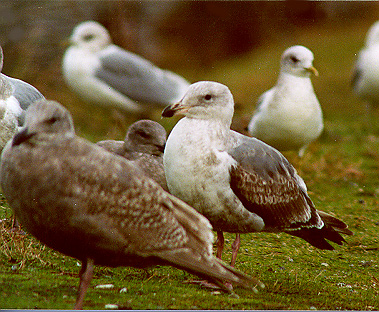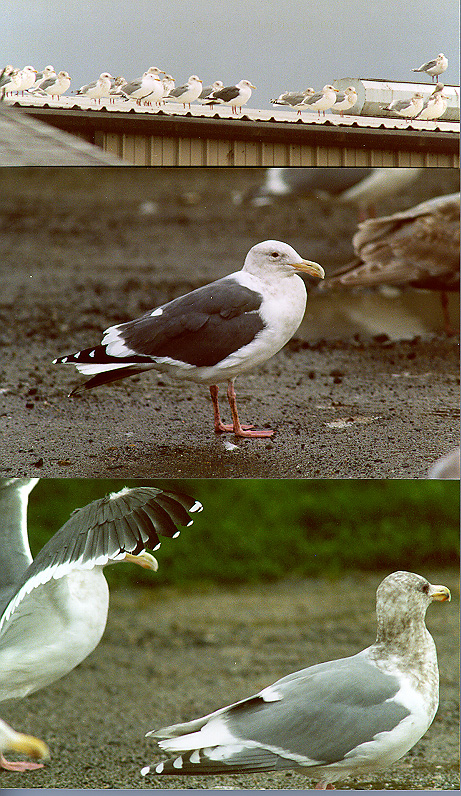Click on a name to see one or more photos of that species. Come back any time, as additional photos may have been included since your last visit.
Slaty-backed Gulls
Here are photos of "Slaty-backed Gulls" reported in Washington during the winter of 1997-98.
Gull 1
The first bird, an apparent adult in basic plumage, was found by Steve Hampton at Gog-le-hi-te Wetlands, Tacoma, and photographed by Ruth Sullivan. It could be the same bird that was present at this spot 4 years ago, although it's impossible to say.
Slaty-backed Gull
Tacoma, WA
January 3, 1998
Slaty-backed Gull
Tacoma, WA
January 9, 1998
Why is this a Slaty-backed Gull?
- Very dark mantle.
- Rather slender bill, giving the head somewhat the look of a Thayer's Gull.
- Fine brown streaks on the head and neck, with a concentration of dark pigment in an almost-stripe just before and behind the eye. Compare with the Glaucous-winged Gull in one photo.
The second photo shows the characteristic pattern of a "string of pearls" in the outer primaries characteristic of Slaty-backed.
Gull 2
The second bird, considered in third-basic plumage because of bill color (actually more typical of a much younger bird), lack of white primary tips, and some black in the tail, was discovered by Steve Mlodinov at Everett earlier this winter and was photographed there, also by Ruth Sullivan. It has been called a Slaty-backed by some observers, but I consider it a Western Gull.
Western Gull
Everett, WA
December 30, 1997
Western Gull
Everett, WA
December 30, 1997
Why is this not a Slaty-backed Gull?
- Mantle dark but no darker than many Western Gulls in this area. Note that the mantle color looks different in the first pair of photos; lighting affects gull mantle color strongly, and all suspected rare gulls should be photographed with other known species to facilitate comparison. The bird in front of this individual in the second pair of photos is a Glaucous-winged x Western hybrid, not that much paler than the mystery bird.
- Very heavy bill. This bill is typical of Western and too large for Slaty-backed, in my experience.
- Gray, almost mottled, streaking on the head and neck, with a relatively large dusky area on the side of the head.
- No "string of pearls" showing in photo of underwings (bird on parking divider), and these are said to show up in third-year birds. Compare with the Western Gull to the left.
I don't see anything about this bird that points toward Slaty-backed. The great amount of white on the secondary tips has been much overemphasized as a field mark for the species; my suspicion is that it is the contrast with the very dark mantle that makes it so prominent in Slaty-backs. A yellowish eye is commonplace in Western Gulls.
Gull 3
The following photo, of a second-year Western Gull, was taken by Ruth Sullivan at Titlow Beach in Tacoma. Compare its bill, head markings, and mantle color with those of the Everett bird (you'll have to use your memory as you go backward and forward; sorry).

Tacoma, WA
January 1998
Gull 4
This bird, an adult, was photographed by Ruth Sullivan at Gog-le-hi-te in Tacoma, the site of the bona fide Slaty-backed Gull this winter. It has also been called a Slaty-backed by some observers, but I consider it a Western Gull.

Tacoma, WA
January 24, 1998
Why is this not a Slaty-backed Gull?
The uppermost photo shows the bird with a flock of mostly Thayer's Gulls. It looks very dark because it's compared with one of the lighter-mantled species, i.e., no Westerns or Western X Glaucous-winged in the photo. Actually, it does seem to be quite dark, certainly within the range of Slaty-backed, but I consider it also within the range of the darkest Westerns. However, note that in the bottom photo the same bird doesn't look all that dark in comparison with the Glaucous-winged. Ruth assures me these are all the same bird, and her photos all show a bird with a droopy left wing. I think its bill is too large for a Slaty-backed, it has no indication of the Slaty-backed winter head pattern (which I think would persist to this date), and the lowermost photo shows the relative lack of white subterminal markings ("string of pearls") in the outer primaries. The paleness of the bill represents individual variation in Westerns, not a sign for Slaty-backed. I don't see anything about it that indicates it couldn't be a Western Gull, and, of course, the parsimonious conclusion is the preferred one when it comes to considering a bird a common vs. a rare species.